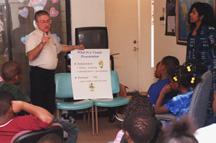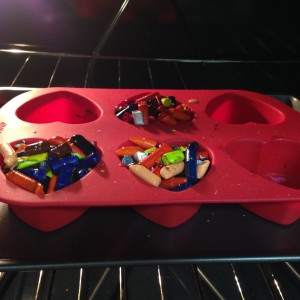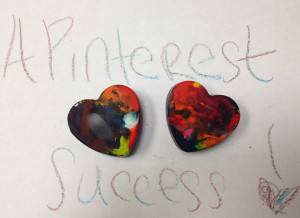by pmdavis | Apr 3, 2015

Dying eggs with natural materials is a fun 4-H club activity that teaches a little science too!
This time of year, many children are egg-cited to dye Easter Eggs! This year, instead of buying a kit to dye eggs, why not use natural materials that you most likely already have in your kitchen or yard? One 4-H Junior Master Gardener Project teaches young gardeners how to make dyes made from plant parts and other natural materials and teach a little science at the same time.
Start by cleaning the eggs by wiping them with vinegar. Why vinegar? Well there is a little science behind that…and a great teachable moment! The shell is protected by a thin layer of protein molecules called the cuticle. This cuticle has a neutral charge so not much is attracted to it. The vinegar contains acetic acid, which reacts to make the cuticle positively charged. The dye typically has a negative charge. So to get the dye to “stick” to the egg, the positive charge on the cuticle attracts the negative charge of the dye. (Use a magnet as a visual example.) Therefore the acid is needed to make the color adhere to the shell. FYI! If the egg is left in the acid it will make the shell disappear. (A great experiment for another day)
Back to dyes…Talk to youth about how early Americans made their own dyes. Look around your house to see what might make a good dye and predict what color it will make setting up your own mini science experiment. To make your dyes mix 1-4 cups of plant material or 2 to 4 tablespoons of ground herbs or spices with 1-2 quarts of water in a pot. Bring the mixture to a boil, turn off and steep until cool. Strain, keep liquid and discard plant materials. Juices can be used as is. Soak eggs in the liquid/juice dyes + 1 teaspoon of vinegar – the longer soaked the brighter. If soaking eggs for extended periods, store eggs with dye in the refrigerator. Easter eggs are safe if handled properly. They must not be out of the refrigerator for more than 2 hours.
Ideas for dyes:
- Blue to Purple– grape juice, red grapes, blueberries, red cabbage, blackberries
- Reddish Pink Purple– paprika, red onion skins; beets/beet juice, Cranberries, Hibiscus Flowers, Red teas (Passion, Hibiscus)
- Brown– coffee, black tea
- Golden Orange– yellow onion skins
- Orange– turmeric, ground cumin, yellow onionskins plus beet juice, paprika Green– spinach, kale, parsley, carrot tops.
- Yellow– curry powder, orange and lemon peels, Safflower Petals
For cool effects before cooking/dyeing:
- Draw on your egg with crayons
- Wrap your egg with rubber bands or yarn for a tie-dyed effect
- For a marbled effect, put 1 Tbsp oil in the dye before dropping your egg in
- Stamp your eggs with nature images by placing a leaf or flower on your egg, then wrapping it tightly with a piece of nylon stocking. Dip into dye. When you remove your egg from the dye, carefully remove wrappings.

Use leaves or flowers to make interesting prints on your eggs.
Cool effects after cooking/dyeing:
- Sprinkle with salt while still wet and see what pattern emerges!
- For a mottled egg, rub/pat it with paper towel as soon as you remove it from the dye
- Draw with markers when your egg is dry
- To make your eggs gleam, rub vegetable oil on egg after cooled and dried.
These and other activities are part of 4-H, one of the nation’s most diverse organizations. 4-H includes people from all economic, racial, social, political, and geographic categories. There are no barriers to participation by any young person. Participants are given the opportunity to engage in activities that hold their personal interest, while being guided by caring and trained adult volunteers. For more information about joining 4-H as a youth or volunteer, contact your local UF/IFAS Extension Office or visit http://florida4h.org.
by Heather Kent | Mar 20, 2015

Florida 4-H Recognition Model
Recognition is a basic human need and can help build positive self esteem if handled in the right way and is an important part of the Florida 4-H Program. Whitney Cherry and Karen Miliffe shared tips for club leaders on showing recognition in 4-H clubs during the March Make a Difference Monday session earlier this month. If you missed it, you can view the recorded session at http://florida4h.org/madmondays.
Recognition is more meaningful when it occurs soon after it is earned and is related to a specific task. It can take multiple forms– appropriate recognition varies depending on age, past experience, family lifestyle, community and cultural heritage. Recognition motivates people to excel and take risks and in 4-H, it is the acknowledgement and affirmation of personal growth of an individual or group (such as a club). Awards are simply the things we give people or groups to symbolize our recognition of their accomplishments or effort.
The Florida 4-H Recognition Model includes five types of accomplishments or goals. The five types of accomplishments that 4-H measurers for recognition are:
- Participation in educational experiences (certificates, t-shirts, participation ribbons). The requirements for recognition for participation in a 4-H event are well publicized and easy to achieve. These types of recognition can be earned many times and are usually not expensive, but valued.
- Progress toward self-set goals. It is important for youth to learn to set goals and work towards them. 4-H project books are one way that we provide feedback on self-set goals. The club annual program is a tool for setting the collective goals of the club. As volunteers, we can assist youth with this by reviewing their goals frequently during the 4-H year, identifying what they have accomplished so far and helping them determine their next steps toward a goal.
- Achieving standards of excellence. In 4-H standards are used in two ways:
- Standards are established by subject matter and youth development specialists to provide a basis for young people to plan and work toward their goals
- Professional staff and /or volunteers and young people work together to establish standards– such as dress code at 4-H University, expectations of 4-Hers in club meetings, desired behavior at 4-H events/ camp
- Excelling in peer competition (judging contests, speaking contests, exhibits, animal exhibits and shows, portfolios, project book contests). Competition has long been a component in the 4-H program. 4-H strives to make competition an educational process and an opportunity to teach youth life skills. Peer competition is competing against one another’s peers. Numerous competition exist form the local club level, county, district, state, regional and national. 4-H also provides opportunities for clubs to compete against other clubs with the Club Standards of Excellence and Community Pride programs. Keep in mind that competition is not suitable for all ages (members 5-7 years old) and competition rules and procedures should be clear.
- Excelling in cooperation within a group (team or club awards or media recognition for service projects). From the beginning 4-H has encouraged young people to work together to learn. Cooperation engages young people in group experiences that are interdependent– face-to-face interactions, individual and group responsibility, group skills development. Cooperation involves everyone in the group and uses mutually agreed upon goals.
Recognition is a significant incentive to further learning. When properly used, it inspires young people to belong. Through caring adults and peers, in an inclusive and safe environment, recognition helps meets the needs of young people. Youth become and stay active in 4-H because they benefit. 4-H provides many opportunities for volunteers to make a difference in the lives of young people. If every young person could step into 4-H, imagine all the resourceful problem solvers, skilled workers, and capable leaders they’d become. That future is in our reach if we all lend our time and talents to guide the young people who will create it. Make the investment of a lifetime- become a 4-H volunteer, and inspire the next generation!
by Heather Kent | Mar 6, 2015
 Have you ever attended a meeting for the first time and felt a little out of place? Do you remember that nervous feeling; the pit in your stomach of not knowing anyone, not sure if you belonged? Creating a welcoming environment in 4-H clubs and events helps members and volunteers have a sense of belonging. A sense of belonging is one of the Essential Elements of Positive Youth Development. Last month, Georgene Bender and Jon Mayer shared ideas for creating a welcoming environment in your 4-H club during our February Make a Difference Monday session.
Have you ever attended a meeting for the first time and felt a little out of place? Do you remember that nervous feeling; the pit in your stomach of not knowing anyone, not sure if you belonged? Creating a welcoming environment in 4-H clubs and events helps members and volunteers have a sense of belonging. A sense of belonging is one of the Essential Elements of Positive Youth Development. Last month, Georgene Bender and Jon Mayer shared ideas for creating a welcoming environment in your 4-H club during our February Make a Difference Monday session.
1. Welcome new members– have a welcome committee for your club. This committee can be a group of members or even a 4-H family that is willing to come to the meeting early to welcome any new members. They could even prepare a welcome packet with 4-H enrollment information, club brochure, calendar, 4-H pen or pencil, or even a club t-shirt. You can ask your 4-H agent for some ideas or items to include in the welcome packet. There are many inexpensive “4-H trinkets” for $1.00 or less available at the 4-H Mall. Assigning 4-H families to mentor new 4-H families is also a great way to mentor and orient new members.
- Plan “get acquainted games”- it’s difficult to feel comfortable in a group when you don’t know people well. Leading get acquainted activities during club meetings (especially at the beginning of the club year) will help establish a friendlier club environment. Ice breakers, get acquainted games, or even roll calls that ask questions about member’s interests (answer roll by making the sound of your favorite animal) can help members get to know each other better.
- Encourage engagement– a great way to get new members involved is to use the 4-H Clover worksheet to help plan the club year. If the member joins after the club planning meeting, get them involved in a committee. Smaller committees are less intimidating and can help new members feel like they belong and have something to contribute.
What will you do this year to help make new members feel welcome? Leave us a comment below! To learn more about creating welcoming environments in 4-H clubs, you can view the full, 1-hour workshop online at http://florida4h.org/madmondays.
by Yolanda Goode | Feb 27, 2015

My Heart to Greater Loyalty…
A handwritten note or card can express one’s gratitude, thankfulness, care, or encouragement and has not gone extinct even in this age of technology. Just think about the last time you received a personal handwritten note from someone. You may have gotten emails, texts, or posts relating to the same event and you appreciated it all but isn’t there just something a little extra special about receiving a written note?
Florida 4-H helps youth develop life skills. Life skills are those competencies (measurable or observable knowledge, skills, abilities, and behaviors) that assist people in functioning well in the environments in which they live. Life skills are transferable which makes them different from task specific skills like tying a bow or knot.
In February we think of all things related to the heart due to Valentine’s Day. The second H in 4-H stands for the Heart. Looking at Targeting Life Skills in 4-H, the Heart has two life skills subcategories; caring and relating. The specific life skills under caring are empathy, sharing, nurturing relationships, and concern for others. Youth need an opportunity to demonstrate these skills throughout the year.
This takes us back to the handwritten note and your call to action to cultivate the art of note writing in our youth and give them another outlet of expressing the life skills connected to the second H in 4-H.
Tips to Get Started
- Collection of note cards (Cards could be club themed and can even be hand-made by youth)
- Good writing pens
- Stamps (Unless personally delivering them)
- Keep supplies in your 4-H club box so that you will have them when you need them
According to David Horsager, notes should be specific, personalized, and authentic (S.P.A.) The note does not have to be long. Younger members, such as cloverbuds may just want to draw a picture that expresses thanks or encouragement. If having youth write cards, teach them want should be included in an artful handwritten note:
- What they are thankful for or what they want to encourage or motivate someone about
- How the person has benefited them or how they will use the gift
Even as adults we can demonstrate the life skills under caring. One of my goals this year is to more deliberate and intentional when writing personal notes for work, family, or friends. With practice, this will become easier and having my supplies at work and home will help me get that personalized out and make someone’s day a little brighter and better. What will you do differently this year to model the 2nd “H” in 4-H? Leave us a comment below!
~this article was written by Yolanda Goode, 4-H Agent in Gadsden County
by Stefanie Prevatt | Feb 13, 2015
I have a love-hate relationship with Pinterest. I am, admittedly, a perfectionist. And Pinterest sets me up for failure. Perhaps it’s because I am the least crafty person you will ever meet, but nothing ever turns out the way it looks in the photos. Yet, I keep searching and trying new things.
Today’s Pinterest find was a neat little project I found here. I was immediately drawn in by the cute little hearts and the idea that no sweets are involved! Upon exploring this project further, I came to believe this had success written all over it: find crayons, chop up crayons, melt. Easy peasy. Turns out, things were a little more complicated than that, but I would still suggest this as a doable project for 4-H’ers of any age (with proper adult supervision, of course).
Crayon Hearts
1. Collect used crayons. Ask members to bring them to your meeting. You want a good mixture or bright and dark colors.
2. Peel paper off crayons. This was by far the most tedious task. If you will be doing this activity with younger 4-H’ers, I would bring the crayons already peeled.
3. Cut crayons into small pieces. Upon completing this, I realized I should have cut mine a little smaller to help with their melting.

cut crayons
4. Put crayons in silicone baking tray. 230 degrees for 15-20 mins.

baking crayons
5. Let heart crayons cool and remove (more like peal) from tray.
Now what?
There is so much more to this activity than breaking crayons and melting them into hearts.
- Teamwork is required to prepare all the materials. Don’t forget, crayons won’t peal themselves!
- Planning and organizing are required if youth want to have hearts turn out a certain color. Check out these crayons.
- Decision making is necessary to figure out what will be done with the crayon hearts.
- Should the hearts be donated to a local children’s hospital or Ronald McDonald House?
- Older youth can figure out the per item cost of each heart and compare it to the cost of store-bought gifts.
Whether you need something related to your specific project area or you are seeking an idea for a fun, themed activity, Pinterest will certainly not disappoint. Don’t forget, even if your activity turns into a Pinterest fail, celebrate the teachable moments and successes along the way!

A Pinterest success!
References:
Crayon hearts: https://www.pinterest.com/pin/115334440431430268/
Nifty crayon hearts: https://www.pinterest.com/pin/409898003556943584/
by Whitney Cherry | Feb 6, 2015

Don’t let the weather ruin your club’s recreational time. Play inside!
It’s that time of year in North Florida when we’re not sure what we’ll wake up to each morning. We may be in short sleeves, sweatshirts, or hip waders and that can make planning a club meeting tough. During this time of year, between the cold and the rain, it’s seldom that our youth are allowed to go outside for PE. And in lower grades, where a gym may not be available, they are often not getting any significant amount of physical activity during the school day. This is neither good for their mental or physical health, so how can we combat the winter-blues in our club meetings? Here are a few suggestions:
Indoor relay and tag games: If space permits, move the furniture out of the way, and let the kids play freeze tag or have a relay race. Relays are often easy to relate to the educational topic of your meeting. Examples include:
- Set the table relay: where youth draw a piece of a table setting out of a paper bag, run to a table across the room, and put it in its proper place on the table. (the floor can be used in place of a table if need be.) The first team to correctly set the table wins.
- Salsa relay: youth put plastic tomatoes or peppers or onions or garlic between their knees and “run/waddle” around a cone, chair, or tape mark, at the other end of the room back to their team where they pass on their piece of food to the next team mate. The first team to have each player complete the task wins.
- Traditional balloon and ring races are always good too.
Exercise bingo: Contact your local extension office for a copy of exercise bingo. In this high intensity game, each youth or team of youth, is given a bingo card and a stack of exercise cards which face down on the floor. A teammate flips an exercise card, and each team member completes the task on the card (arm circles, pushups, jumping jacks, etc.) If their bingo card includes this exercise, the team captain marks that spot off of their card. Teammates take turn flipping exercise cards until they have Bingo. The first team to get Bingo wins.
Simon Says, Duck-Duck-Goose, London Bridge: These games require only a little space, and are still fun for younger youth, especially Cloverbuds (4-7 yrs). Simon says can often relate to your educational program as well. Ex – “Simon says comb your steer.” “Simon says, stir the batter.” “Simon says bait your hook.”
Legos, board games, etc.: It’s not very active, we know, but sometimes space just doesn’t allow for much physical activity, but it’s still important for youth to have time to interact with each other and relax. Be sure not to pick board games that may take hours to complete. Things like Charades, Guestures, Win, Lose or Draw, etc. are great options.
Now it’s your turn. Get creative, and in the comments section below, share with us the ideas you have for indoor recreation!









